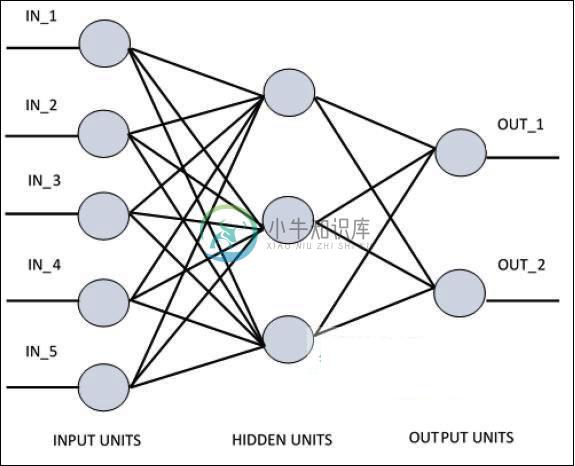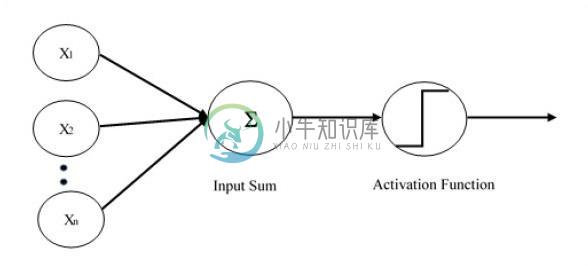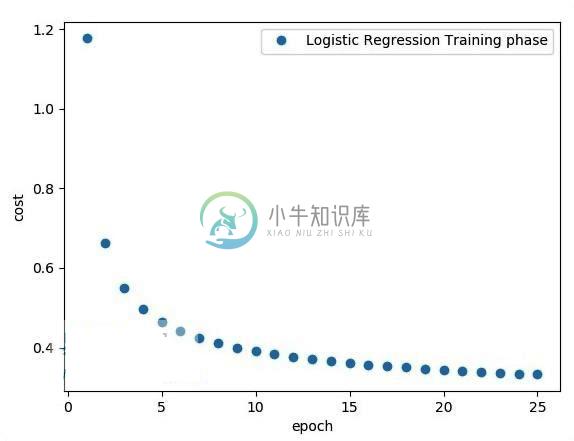TensorFlow单层感知
精华
小牛编辑
131浏览
2023-03-14
理解人工神经网络(ANN)对于要理解单层感知器非常重要。人工神经网络是信息处理系统,其机制受到生物神经回路功能的启发。人工神经网络拥有许多彼此连接的处理单元。以下是人工神经网络的示意图 -

该图显示隐藏单元与外部层通信。而输入和输出单元仅通过网络的隐藏层进行通信。
与节点的连接模式,输入和输出之间的总层数和节点级别以及每层的神经元数量定义了神经网络的体系结构。
有两种类型的架构。这些类型关注功能人工神经网络如下 -
- 单层感知器
- 多层感知器
单层感知器
单层感知器是第一个提出的神经模型。神经元的局部记忆的内容由权重向量组成。单层感知器的计算是在输入矢量的和的计算中执行的,每个输入矢量的值乘以权重的矢量的相应元素。输出中显示的值将是激活功能的输入。

下面来看看如何使用TensorFlow实现图像分类问题的单层感知器。说明单层感知器的最好例子是通过“Logistic回归”的表示。
现在,考虑以下训训练逻辑回归的基本步骤 -
- 在训练开始时用随机值初始化权重。
- 对于训练集的每个元素,使用期望输出和实际输出之间的差异来计算误差。计算的误差用于调整权重。
- 重复该过程,直到整个训练集上的错误不小于指定的阈值,直到达到最大迭代次数。
下面提到了评估逻辑回归的完整代码 -
# Import MINST data
from tensorflow.examples.tutorials.mnist import input_data
mnist = input_data.read_data_sets("/tmp/data/", one_hot = True)
import tensorflow as tf
import matplotlib.pyplot as plt
# Parameters
learning_rate = 0.01
training_epochs = 25
batch_size = 100
display_step = 1
# tf Graph Input
x = tf.placeholder("float", [None, 784]) # mnist data image of shape 28*28 = 784
y = tf.placeholder("float", [None, 10]) # 0-9 digits recognition => 10 classes
# Create model
# Set model weights
W = tf.Variable(tf.zeros([784, 10]))
b = tf.Variable(tf.zeros([10]))
# Construct model
activation = tf.nn.softmax(tf.matmul(x, W) + b) # Softmax
# Minimize error using cross entropy
cross_entropy = y*tf.log(activation)
cost = tf.reduce_mean(-tf.reduce_sum(cross_entropy,reduction_indices = 1))
optimizer = tf.train.GradientDescentOptimizer(learning_rate).minimize(cost)
#Plot settings
avg_set = []
epoch_set = []
# Initializing the variables init = tf.initialize_all_variables()
# Launch the graph
with tf.Session() as sess:
sess.run(init)
# Training cycle
for epoch in range(training_epochs):
avg_cost = 0.
total_batch = int(mnist.train.num_examples/batch_size)
# Loop over all batches
for i in range(total_batch):
batch_xs, batch_ys = mnist.train.next_batch(batch_size)
# Fit training using batch data sess.run(optimizer, feed_dict = {
x: batch_xs, y: batch_ys})
# Compute average loss avg_cost += sess.run(cost, feed_dict = {
x: batch_xs, y: batch_ys})/total_batch
# Display logs per epoch step
if epoch % display_step == 0:
print ("Epoch:", '%04d' % (epoch+1), "cost=", "{:.9f}".format(avg_cost))
avg_set.append(avg_cost) epoch_set.append(epoch+1)
print ("Training phase finished")
plt.plot(epoch_set,avg_set, 'o', label = 'Logistic Regression Training phase')
plt.ylabel('cost')
plt.xlabel('epoch')
plt.legend()
plt.show()
# Test model
correct_prediction = tf.equal(tf.argmax(activation, 1), tf.argmax(y, 1))
# Calculate accuracy
accuracy = tf.reduce_mean(tf.cast(correct_prediction, "float")) print
("Model accuracy:", accuracy.eval({x: mnist.test.images, y: mnist.test.labels}))
执行上面的代码生成以下输出 -
逻辑回归也认为是预测分析。逻辑回归用于描述数据并解释一个从属二元变量与一个或多个名义或自变量之间的关系。

